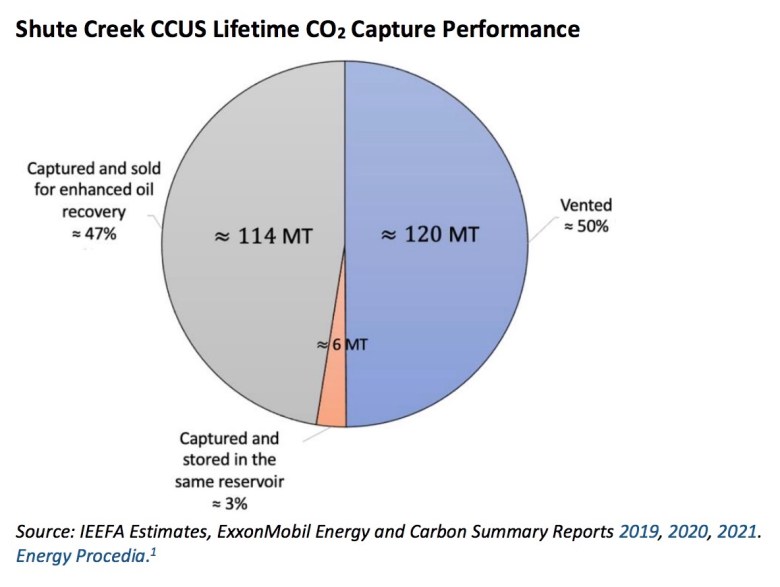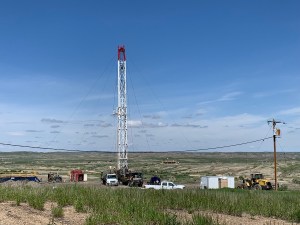ExxonMobil has received a federal permit to inject CO2 for permanent underground storage below public Bureau of Land Management property in southwest Wyoming.
The company will inject up to 60 million cubic feet of CO2 per day from its Shute Creek natural gas processing facility near La Barge, according to the BLM. The greenhouse gas will be stored in a briny portion of the Madison Aquifer some 18,000 feet below the surface in an area that straddles the border between Lincoln and Sweetwater counties.
The permit is a first-of-its-kind for the BLM. The agency issued new guidance in June authorizing underground CO2 storage on BLM-managed lands as part of the Biden administration’s initiatives to curb greenhouse gas emissions.
“This project is a prime example of how the BLM can work together with industry leaders to combat climate change,” Wyoming BLM State Director Andrew Archuleta said in a press release.
The permit is a significant step forward for ExxonMobil’s plans to expand its CO2 capture and sequestration program at Shute Creek, touted as one of the largest in the world. But the Shute Creek CO2 program is not without its critics.
About half the volume of CO2 that’s been captured or separated from the raw natural gas stream at the facility — approximately 120 million tons — has been vented into the atmosphere since it began operations in 1986, according to a March 2022 report by the Institute for Energy Economics and Finance Analysis. About 114 million tons of captured CO2 have been sold for enhanced oil recovery — the process of injecting CO2 into marginal oil fields to produce more oil.
 This chart depicts volumes of CO2 vented compared to volumes used for enhanced oil recovery. (Institute for Energy Economics and Finance Analysis)
This chart depicts volumes of CO2 vented compared to volumes used for enhanced oil recovery. (Institute for Energy Economics and Finance Analysis)
Shute Creek emitted more than 3.4 million tons of CO2 in 2020, according to U.S. Environmental Protection Agency data. If fully implemented, the plan to sequester an additional 60 million cubic feet of CO2 per day — or 1.2 million tons annually — would cut Shute Creek’s CO2 venting by about 35%.
Shute Creek CO2
The Shute Creek gas plant was among the first facilities in the world to separate CO2 from an industrial process for permanent underground storage. ExxonMobil began selling CO2 to oilfield operators in Colorado and Wyoming, including the Salt Creek oil field near Midwest, in the 1990s.
The company told state regulators it sold an average 207 million cubic feet of CO2 per day in 2007 for enhanced oil recovery but still vented about 200 million cubic per day. The Wyoming Oil and Gas Conservation Commission, in 2008, pressured ExxonMobil to market more CO2 for enhanced oil recovery as Wyoming oil producers were clamoring to take advantage of high oil prices.
The facility still vents into the atmosphere about half the CO2 it produces, according to IEEFA’s analysis. That’s because the economic model for the Shute Creek carbon capture and utilization relies on high oil prices to shore up demand for the CO2.
“The project has been unable to capture the volumes of CO2 it was designed for, not for technical reasons but for economic reasons,” according to the IEEFA report. “For CCUS projects to be economic, it requires a high oil price, and in several cases, government subsidies.”
“This project is a prime example of how the BLM can work together with industry leaders to combat climate change.”
Andrew Archuleta, Wyoming BLM
The Shute Creek CCUS program qualifies under the “Section 45Q” tax credit for carbon sequestration, which historically allowed for about $50 per ton for geologic storage and $35 per ton for CO2 used in enhanced oil recovery. Provisions in the Inflation Reduction Act extend the 45Q tax credit and increase it to $85 per ton for geologic sequestration and $60 per ton for “utilization” of CO2, such as enhanced oil recovery.
The Shute Creek CO2 program remains anything but a climate-friendly endeavor, however, according to IEEFA. That’s because rather than capturing CO2 from industrial processes such as the combustion of fossil fuels, it’s simply moving naturally occurring CO2 from one geologic formation to another while about half is used to produce more oil resulting in human-made CO2 emissions.
“The [Shute Creek] CCUS model should mainly be seen as a subsidy harvesting scheme to prolong the life of the oil and gas industry, not an emission reduction investment,” IEEFA analysts wrote.
However, some conservationists consider any additional volumes of CO2 diverted for geologic storage rather than for enhanced oil recovery or venting into the atmosphere as a positive. “Moving from [enhanced oil recovery] to permanent geological storage on BLM lands is a pretty big shift,” Wyoming Outdoor Council Conservation Advocate John Burrows said.
The post ExxonMobil to store CO2 on BLM lands in Wyoming appeared first on wyomingdigest.com.







